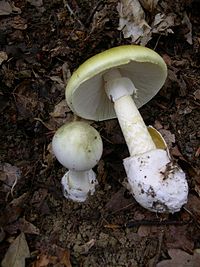Amanita phalloides (generally /æməˈnaɪtə fəˈlɔɪdiːz/), commonly known as the death cap, is a poisonous basidiomycete fungus, one of many in the genus Amanita. Widely distributed across Europe, A. phalloides associates with various deciduous trees. In some cases, death cap has been accidentally introduced to new regions with the cultivation of non-native species of oak, chestnut, and pine. The large fruiting bodies (i.e., the mushrooms) appear in summer and autumn; the caps are generally greenish in colour, with a white stipe and gills.
Coincidentally, these toxic mushrooms resemble several edible species (most notably the straw mushroom) commonly consumed by humans, increasing the risk of accidental poisoning. A. phalloides is one of the most poisonous of all known toadstools. It has been involved in the majority of human deaths from mushroom poisoning, possibly including the deaths of Roman Emperor Claudius and Holy Roman Emperor Charles VI. It has been the subject of much research, and many of its biologically active agents have been isolated. The principal toxic constituent is α-amanitin, which damages the liver and kidneys, often fatally. No definitive antidote is known.
